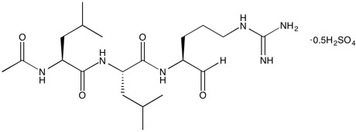Leupeptin hemisulfate | Trypsin-like cysteine protease inhibitor
NMR (Conforms)

Available Options
| Size : | Price | Quantity | |
|---|---|---|---|
| 25 mg | $80.00 | ||
| 100 mg | $240.00 |
Leupeptin hemisulfate (103476-89-7) is a reversible inhibitor of trypsin-like proteases and cysteine proteases. Inhibits trypsin, plasmin, papain and cathepsin B, H and L.1-3 Blocks various apoptotic pathways in T cells.4 Commonly used in cell lysis buffers to protect proteins from degradation. Typical working concentration is 1µM (0.5 µg/ml).
References/Citations:
1) Aoyagi et al. (1969), Leupeptins, new protease inhibitors from Actinomycetes; J. Antibiot., 22 283
2) Barrett et al. (1981), Cathepsin B, Cathepsin H and Cathepsin L; Methods Enzymol., Pt C, 80 535
3) Knight et al. (1980), Human cathepsin B. Application of the substrate N-benzyloxycarbonyl-L-arginyl-L-arginine 2-naphthylamide to a study of the inhibition by leupeptin; Biochem. J., 189 447
4) Sarin et al. (1995), A protease-dependent TCR-induced death pathway in mature lymphocytes; J. Immunol., 154 5806
NMR (Conforms)
Safety Data Sheet:
Product Data Sheet:
Materials provided by Focus Biomolecules are for laboratory research use only and are not intended for human or veterinary applications. Please note that we do not sell to individuals and that all orders placed by non-research organizations will incur a $20 restocking/refund fee
Leupeptin hemisulfate (103476-89-7) is a reversible inhibitor of trypsin-like proteases and cysteine proteases. Inhibits trypsin, plasmin, papain and cathepsin B, H and L.1-3 Blocks various apoptotic pathways in T cells.4 Commonly used in cell lysis buffers to protect proteins from degradation. Typical working concentration is 1µM (0.5 µg/ml).
References/Citations:
1) Aoyagi et al. (1969), Leupeptins, new protease inhibitors from Actinomycetes; J. Antibiot., 22 283
2) Barrett et al. (1981), Cathepsin B, Cathepsin H and Cathepsin L; Methods Enzymol., Pt C, 80 535
3) Knight et al. (1980), Human cathepsin B. Application of the substrate N-benzyloxycarbonyl-L-arginyl-L-arginine 2-naphthylamide to a study of the inhibition by leupeptin; Biochem. J., 189 447
4) Sarin et al. (1995), A protease-dependent TCR-induced death pathway in mature lymphocytes; J. Immunol., 154 5806
Calculate the molar concentration, mass or volume in a solution.
Concentration × Volume × Molecular Weight = Mass
Focus Biomolecules • Plymouth Meeting, PA USA • 1-855-FOCUS21
Focus Biomolecules
Plymouth Meeting, PA USA
1-855-FOCUS21
Website Created by Advanta Advertising LLC.

